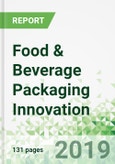Food & Beverage Packaging Innovation
Sales of food and beverage containers are forecast to increase 3.1% per year to $70 billion in 2023. As consumer preferences and priorities evolve, both packaging and food and beverage companies look for ways to innovate, allowing their packaged goods to not only meet the needs of consumers, but also stand out on store shelves. Packaging can address these changes through developments in the container itself, the closure mechanisms, or even their labels. Opportunities exist in packaging that addresses key concerns such as
Convenience – e.g., single serving, resealable, designed for on-the-go consumption
Sustainability – e.g., greater recycled content, environmentally friendly disposal, reusable, limits food waste
Improved experience – e.g., playful elements and interactive features
Product quality protection – e.g., longer shelf life, easier way of knowing when a product is spoiled
E-commerce – e.g., lighter weight, greater durability and packaging integrity
Scope of the Report
This report analyzes shifting and emerging trends in food and beverage packaging, focusing especially on new forms of packaging food and beverage marketers are using, and consumer attitudes and behaviors regarding food and beverage packaging. Included are packaging innovations from around the world, but the focus is on how innovation will shape the US packaging market. It presents historical data (2008, 2013, and 2018) and forecasts (2023) for food and beverage containers, US e-commerce sales, global e-commerce packaging, active and intelligent packaging, and packaging material mix. Consumer attitudes and behavior concerning packaging and recycling from proprietary Freedonia US national consumer surveys are presented.
Sales of food and beverage containers are forecast to increase 3.1% per year to $70 billion in 2023. As consumer preferences and priorities evolve, both packaging and food and beverage companies look for ways to innovate, allowing their packaged goods to not only meet the needs of consumers, but also stand out on store shelves. Packaging can address these changes through developments in the container itself, the closure mechanisms, or even their labels. Opportunities exist in packaging that addresses key concerns such as
Convenience – e.g., single serving, resealable, designed for on-the-go consumption
Sustainability – e.g., greater recycled content, environmentally friendly disposal, reusable, limits food waste
Improved experience – e.g., playful elements and interactive features
Product quality protection – e.g., longer shelf life, easier way of knowing when a product is spoiled
E-commerce – e.g., lighter weight, greater durability and packaging integrity
Scope of the Report
This report analyzes shifting and emerging trends in food and beverage packaging, focusing especially on new forms of packaging food and beverage marketers are using, and consumer attitudes and behaviors regarding food and beverage packaging. Included are packaging innovations from around the world, but the focus is on how innovation will shape the US packaging market. It presents historical data (2008, 2013, and 2018) and forecasts (2023) for food and beverage containers, US e-commerce sales, global e-commerce packaging, active and intelligent packaging, and packaging material mix. Consumer attitudes and behavior concerning packaging and recycling from proprietary Freedonia US national consumer surveys are presented.
Table of Contents
1. EXECUTIVE SUMMARY
2. OVERVIEW
3. CONSUMER INSIGHTS
4. INNOVATIONS
5. INNOVATIVE FOOD & BEVERAGE TECHNOLOGIES
6. APPENDIX
LIST OF TABLES
LIST OF FIGURES








